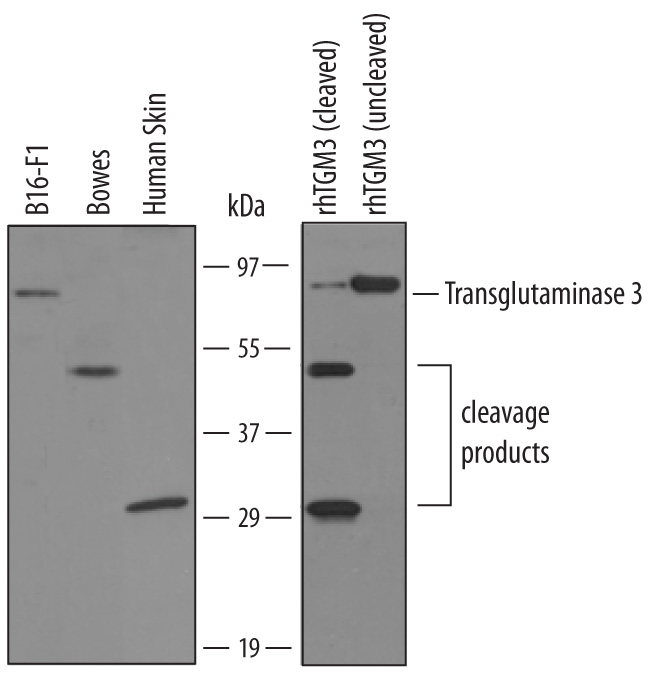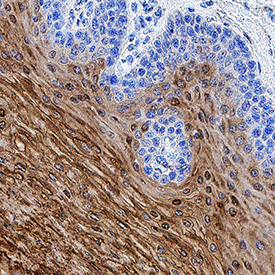Human Transglutaminase 3/TGM3 Antibody Summary
Ala2-Glu693
Accession # NP_003236
Applications
Please Note: Optimal dilutions should be determined by each laboratory for each application. General Protocols are available in the Technical Information section on our website.
Scientific Data
 View Larger
View Larger
Detection of Human and Mouse Transglutaminase 3/TGM3 by Western Blot. Western blot shows lysates of B16-F1 mouse melanoma cell line, Bowes human melanoma cell line, and human skin tissue. PVDF Membrane was probed with 1 µg/mL of Human Transglutaminase 3/TGM3 Antigen Affinity-purified Polyclonal Antibody (Catalog # AF4604) followed by HRP-conjugated Anti-Sheep IgG Secondary Antibody (Catalog # HAF016). For additional reference, Recombinant Human Transglutaminase 3/TGM3 (Catalog # 4604-TG) (10 ng/lane) uncleaved and cleaved by recombinant human Cathepsin were included. Specific bands were detected for uncleaved Transglutaminase 3/TGM3 at approximately 77 kDa (as indicated) and Transglutaminase 3/TGM3 cleavage products at approximately 50 and 30 kDa (as indicated). This experiment was conducted under reducing conditions and using Immunoblot Buffer Group 1.
 View Larger
View Larger
Transglutaminase 3/TGM3 in Human Esophagus. Transglutaminase 3/TGM3 was detected in immersion fixed paraffin-embedded sections of human esophagus using Human Transglutaminase 3/TGM3 Antigen Affinity-purified Polyclonal Antibody (Catalog # AF4604) at 10 µg/mL overnight at 4 °C. Before incubation with the primary antibody, tissue was subjected to heat-induced epitope retrieval using Antigen Retrieval Reagent-Basic (Catalog # CTS013). Tissue was stained using the Anti-Sheep HRP-DAB Cell & Tissue Staining Kit (brown; Catalog # CTS019) and counterstained with hematoxylin (blue). Specific staining was localized to cells in the papillae layer in mucosa. View our protocol for Chromogenic IHC Staining of Paraffin-embedded Tissue Sections.
Reconstitution Calculator
Preparation and Storage
- 12 months from date of receipt, -20 to -70 °C as supplied.
- 1 month, 2 to 8 °C under sterile conditions after reconstitution.
- 6 months, -20 to -70 °C under sterile conditions after reconstitution.
Background: Transglutaminase 3/TGM3
Transglutaminase 3 (TG3), also known as epidermal Transglutaminase (Tgase E), belongs to the family of Transglutaminase enzymes that catalyze the posttranslational modification of proteins via calcium dependent cross-linking reactions (1-3). TG3 is involved in the formation of the cornified envelope in skin keratinocytes (4). It functions to cross-link structural proteins during epidermal terminal differentiation. TG3 has been implicated as the dominant autoantigen in dermatitis herpetiformis (5). TG3 activation requires proteolysis of the 77 kDa zymogen into two fragments of approximately 50 and 27 kDa to form the active enzyme (1).
- Kim, I.G. et al. (1993) J. Biol. Chem. 268:12682.
- Griffin, M. et al. (2002) Biochem. J. 368:377.
- Lorand, L. and R.M. Graham (2003) Nat. Rev. Mol. Cell Biol. 4:140.
- Eckert, R.L. et al. (2005) J. Invest. Dermatol. 124:481.
- Sardy, M. et al. (2002) J. Exp. Med. 195:747.
Product Datasheets
FAQs
No product specific FAQs exist for this product, however you may
View all Antibody FAQsReviews for Human Transglutaminase 3/TGM3 Antibody
There are currently no reviews for this product. Be the first to review Human Transglutaminase 3/TGM3 Antibody and earn rewards!
Have you used Human Transglutaminase 3/TGM3 Antibody?
Submit a review and receive an Amazon gift card.
$25/€18/£15/$25CAN/¥75 Yuan/¥2500 Yen for a review with an image
$10/€7/£6/$10 CAD/¥70 Yuan/¥1110 Yen for a review without an image

